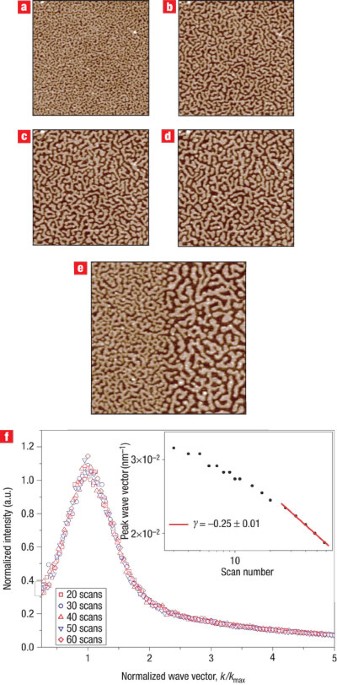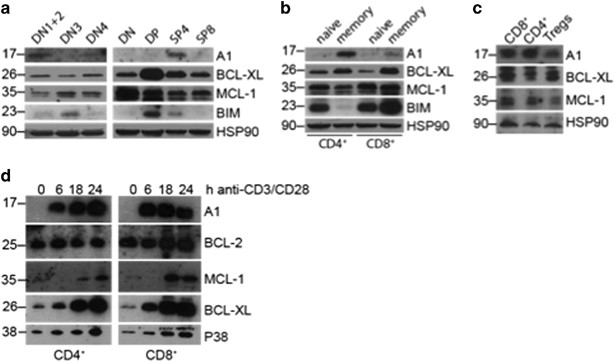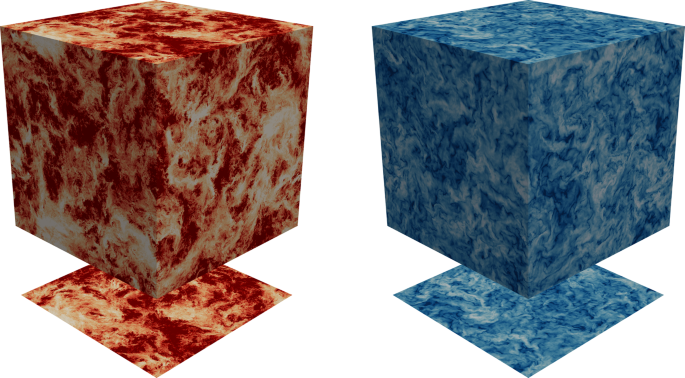
- Select a language for the TTS:
- UK English Female
- UK English Male
- US English Female
- US English Male
- Australian Female
- Australian Male
- Language selected: (auto detect) - EN
Play all audios:
ABSTRACT Coarsening is a ubiquitous phenomenon1,2,3 that underpins countless processes in nature, including epitaxial growth1,3,4, the phase separation of alloys, polymers and binary
fluids2, the growth of bubbles in foams5, and pattern formation in biomembranes6. Here we show, in the first real-time experimental study of the evolution of an adsorbed colloidal
nanoparticle array, that tapping-mode atomic force microscopy (TM-AFM) can drive the coarsening of Au nanoparticle assemblies on silicon surfaces. Although the growth exponent has a strong
dependence on the initial sample morphology, our observations are largely consistent with modified Ostwald ripening processes7,8,9. To date, ripening processes have been exclusively
considered to be thermally activated, but we show that nanoparticle assemblies can be mechanically coerced towards equilibrium, representing a new approach to directed coarsening. This
strategy enables precise control over the evolution of micro- and nanostructures. Access through your institution Buy or subscribe This is a preview of subscription content, access via your
institution ACCESS OPTIONS Access through your institution Subscribe to this journal Receive 12 print issues and online access $259.00 per year only $21.58 per issue Learn more Buy this
article * Purchase on SpringerLink * Instant access to full article PDF Buy now Prices may be subject to local taxes which are calculated during checkout ADDITIONAL ACCESS OPTIONS: * Log in
* Learn about institutional subscriptions * Read our FAQs * Contact customer support SIMILAR CONTENT BEING VIEWED BY OTHERS IMAGING HOW THERMAL CAPILLARY WAVES AND ANISOTROPIC INTERFACIAL
STIFFNESS SHAPE NANOPARTICLE SUPRACRYSTALS Article Open access 11 September 2020 ENGINEERING AND DIRECT IMAGING OF NANOCUBE SELF-ASSEMBLY PATHWAYS Article 06 August 2024 SPONTANEOUS
ORGANIZATION OF SUPRACOLLOIDS INTO THREE-DIMENSIONAL STRUCTURED MATERIALS Article 28 January 2021 REFERENCES * Domb, C & Lebowitz, J. L. (eds) _Phase Transitions and Critical Phenomena_
Vol. 3 (Academic, New York, 1983). * Furukawa, H. A dynamic scaling assumption for phase separation. _Adv. Phys._ 34, 703–750 (1985). Article CAS Google Scholar * Bray, A. J. Coarsening
dynamics of phase-separating systems. _Phil. Trans. R. Soc. Lond. A_ 361, 781–791 (2003). Article CAS Google Scholar * Zinke-Allmang, M. Phase separation on solid surfaces: nucleation,
coarsening, and coalesence kinetics. _Thin Solid Films_ 346, 1–68 (1999). Article CAS Google Scholar * Glazier, J. A. & Weaire, D. The kinetics of cellular patterns. _J. Phys._ 4,
1867–1894 (1992). Google Scholar * John, K. & Bar, M. Alternative mechanisms of structuring biomembranes: Self-assembly versus self-organisation. _Phys. Rev. Lett._ 95, 198101 (2005).
Article Google Scholar * Huse, D. A. Corrections to late-stage behaviour in spinodal decomposition: Lifshitz–Slyozov scaling and Monte Carlo simulations. _Phys. Rev. B_ 34, 7845–7850
(1986). Article CAS Google Scholar * Ernst, H.-J., Fabre, F. & Lapujoulade, J. Observation of dynamic scaling in ‘spinodal decomposition’ in two dimensions. _Phys. Rev. Lett._ 69,
458–461 (1992). Article CAS Google Scholar * Conti, M., Meerson, B., Peleg, A. & Sasorov, P. V. Phase ordering with a global conservation law: Ostwald ripening and coalescence. _Phys.
Rev. E_ 65, 046117 (2002). Article Google Scholar * Ge, G. & Brus, L. Evidence for spinodal phase separation in two-dimensional nanocrystal self-assembly. _J. Phys. Chem. B_ 104,
9573–9575 (2000). Article CAS Google Scholar * Rabani, E., Reichman, D. R., Geissler, P. L. & Brus, L. E. Drying-mediated self-assembly of nanoparticles. _Nature_ 426, 271–274 (2003).
Article CAS Google Scholar * Moriarty, P., Taylor, M. D. R. & Brust, M. Nanostructured cellular networks. _Phys. Rev. Lett._ 89, 248303 (2002). Article CAS Google Scholar *
Martin, C. P., Blunt, M. O. & Moriarty, P. Nanoparticle networks on silicon: self-organized or disorganized? _Nano Lett._ 4, 2389–2392 (2004). Article CAS Google Scholar * Narayanan,
S., Wang. J & Lin, X.-M. Dynamical self-assembly of nanocrystal superlattices during colloidal droplet evaporation by in situ small angle X-ray scattering. _Phys. Rev. Lett._ 93, 135503
(2004). Article Google Scholar * Bigioni, T. P. et al. Kinetically driven self assembly of highly ordered nanoparticle monolayers. _Nature Mater._ 5, 265–270 (2006). Article CAS Google
Scholar * Sztrum, C. G. & Rabani, E. Out-of-equilibrium self-assembly of binary mixtures of nanoparticles. _Adv. Mater._ 18, 565–571 (2006). Article CAS Google Scholar * Ostwald, W.
Z. _Phys. Chem._ 37, 385 (1901). Google Scholar * Wagner, C. Theorie dealtering von Niederschlagen durch umlösen _Z_. _Elektrochem._ 65, 581 (1961). CAS Google Scholar * Wen, J.-M.,
Evans, J. W., Bartelt, M. C., Burnett, J. W. & Thiel, P. A. Coarsening mechanisms in a metal film: From cluster diffusion to vacancy ripening. _Phys. Rev. Lett._ 76, 652–655 (1996).
Article CAS Google Scholar * Morgenstern, K., Laegsgaard, E., Stensgaard, I. & Besenbacher, F. Transition from one-dimensional to two-dimensional island decay on an anisotropic
surface. _Phys. Rev. Lett._ 83, 1613–1616 (1999). Article CAS Google Scholar * Yao, Y., Ebert, Ph., Li, M ., Zhang, Z. & Wang E. G. Decay characteristics of two-dimensional islands on
strongly anisotropic surfaces. _Phys. Rev. B_ 66, 041407 (2002). Article Google Scholar * Brust, M., Walker, M., Bethell, D., Schiffrin, D. J. & Whyman, R. Synthesis of
thiol-derivatised gold nanoparticles in a 2-phase liquid–liquid system. _J. Chem. Soc. Chem. Comm._ 7, 801–802 (1994). Article Google Scholar * Waters, C. A., Mills, A. J., Johnson, K. A.
& Schiffrin, D. J. Purification of dodecanethiol derivatised gold nanoparticles. _Chem. Comm._ 4, 540–541 (2003) Article Google Scholar * Lifshitz, I. M. & Slyozov, V. V. The
kinetics of precipitation from supersaturated solid solutions. _J. Phys. Chem. Sol._ 19, 35–50 (1961). Article Google Scholar Download references ACKNOWLEDGEMENTS We are grateful for the
financial support of the UK Engineering and Physical Sciences Research Council and the EU Framework Programme 6 Marie Curie Research Training Networks scheme (under grant MRTN-CT-2004005728
(PATTERNS)). The grazing incidence small angle X-ray scattering work was performed on the EPSRC-funded XMaS beam line at the ESRF, directed by M.J. Cooper and C. Lucas. We are grateful to
the beam line team of S.D. Brown, L. Bouchenoire, D. Mannix, D.F. Paul and P. Thompson for their invaluable assistance, and to M. Everard, C. Nicklin and R. Williams for both collaborating
on the SAXS experiments and for helpful advice related to nanoparticle synthesis. We also would like to very gratefully acknowledge extremely helpful discussions with P. Mulheran, J.P.
Garrahan, and members of the PATTERNS RTN (in particular, U. Thiele and U. Steiner). AUTHOR INFORMATION AUTHORS AND AFFILIATIONS * School of Physics & Astronomy, University of
Nottingham, Nottingham, NG7 2RD, UK M. O. Blunt, C. P. Martin, M. Ahola-Tuomi, E. Pauliac-Vaujour, P. Sharp & P. J. Moriarty * Department of Physics, University of Turku, Turku,
FIN-20014, Finland M. Ahola-Tuomi * Department of Chemistry, Centre for Nanoscale Science, University of Liverpool, Crown Street, Liverpool, L69 7ZD, UK P. Nativo & M. Brust Authors * M.
O. Blunt View author publications You can also search for this author inPubMed Google Scholar * C. P. Martin View author publications You can also search for this author inPubMed Google
Scholar * M. Ahola-Tuomi View author publications You can also search for this author inPubMed Google Scholar * E. Pauliac-Vaujour View author publications You can also search for this
author inPubMed Google Scholar * P. Sharp View author publications You can also search for this author inPubMed Google Scholar * P. Nativo View author publications You can also search for
this author inPubMed Google Scholar * M. Brust View author publications You can also search for this author inPubMed Google Scholar * P. J. Moriarty View author publications You can also
search for this author inPubMed Google Scholar CONTRIBUTIONS M.O.B. and P.J.M. conceived and designed the experiments. M.O.B., M.A.-T., E.P.-V., and P.S. performed the experiments. M.O.B.,
C.P.M., and P.J.M. analysed the data. C.P.M., P.N., and M.B. contributed materials/analysis tools. M.O.B. and P.J.M. co-wrote the paper. CORRESPONDING AUTHORS Correspondence to M. Brust or
P. J. Moriarty. ETHICS DECLARATIONS COMPETING INTERESTS The authors declare no competing financial interests. SUPPLEMENTARY INFORMATION SUPPLEMENTARY INFORMATION Supplementary video S1 (AVI
1252 kb) SUPPLEMENTARY INFORMATION Supplementary video S2 (AVI 1126 kb) SUPPLEMENTARY INFORMATION Supplementary video S3 (AVI 724 kb) SUPPLEMENTARY INFORMATION Supplementary video S4 (AVI
1636 kb) SUPPLEMENTARY INFORMATION Supplementary video S5 (AVI 874 kb) SUPPLEMENTARY INFORMATION Supplementary video S6 (AVI 1091 kb) SUPPLEMENTARY INFORMATION Supplementary video captions
(PDF 57 kb) RIGHTS AND PERMISSIONS Reprints and permissions ABOUT THIS ARTICLE CITE THIS ARTICLE Blunt, M., Martin, C., Ahola-Tuomi, M. _et al._ Coerced mechanical coarsening of nanoparticle
assemblies. _Nature Nanotech_ 2, 167–170 (2007). https://doi.org/10.1038/nnano.2007.25 Download citation * Received: 14 December 2006 * Accepted: 18 January 2007 * Published: 18 February
2007 * Issue Date: March 2007 * DOI: https://doi.org/10.1038/nnano.2007.25 SHARE THIS ARTICLE Anyone you share the following link with will be able to read this content: Get shareable link
Sorry, a shareable link is not currently available for this article. Copy to clipboard Provided by the Springer Nature SharedIt content-sharing initiative







